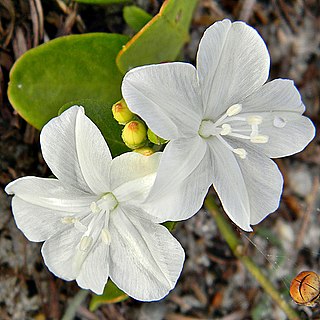
Xylosma is a genus of flowering plants in the family Salicaceae. It contains around 100 species of evergreen shrubs and trees commonly known as brushhollies, xylosmas, or, more ambiguously, "logwoods". The generic name is derived from the Greek words ξύλον (xylon), meaning "wood, tree", and ὀσμή (osmé), meaning "smell", referring to the fragrant wood of some of the species. The Takhtajan system places it in the family Flacourtiaceae, which is considered defunct by the Angiosperm Phylogeny Group.

Calliandra is a genus of flowering plants in the pea family, Fabaceae, in the mimosoid clade of the subfamily Caesalpinioideae. It contains about 140 species that are native to tropical and subtropical regions of the Americas.

Cyphomandra was a formerly accepted genus in the plant family Solanaceae. It used to contain about 35 species native to the Americas from Mexico southwards to Northern Argentina.

Sideroxylon is a genus of trees in the family Sapotaceae described as a genus by Linnaeus in 1753. They are collectively known as bully trees. The generic name is derived from the Greek words σιδηρος (sideros), meaning "iron", and ξύλον (xylon), meaning "wood."
Dussia is a genus of flowering plants in the family Fabaceae. It includes 11 species native to the tropical Americas, ranging from central Mexico to Bolivia and west-central Brazil.

Amyris is a genus of flowering plants in the citrus family, Rutaceae. The generic name is derived from the Greek word αμυρων, which means "intensely scented" and refers to the strong odor of the resin. Members of the genus are commonly known as torchwoods because of their highly flammable wood.

Arachnothryx is a genus of flowering plants in the family Rubiaceae. It contains about 107 species. It is found from Mexico to Peru and in Trinidad.

Gonzalagunia is a genus of plant in the family Rubiaceae.

Maytenus is a genus of flowering plants in the family Celastraceae. Members of the genus are distributed throughout Central and South America, Southeast Asia, Micronesia, and Australasia, the Indian Ocean and Africa. They grow in a very wide variety of climates, from tropical to subpolar. The traditional circumscription of Maytenus was paraphyletic, so many species have been transferred to Denhamia and Gymnosporia.

Rondeletia is a genus of flowering plants in the family Rubiaceae. It is endemic to the Neotropics. There are around 160 species.

Jacquemontia is a genus of plants in the morning glory family Convolvulaceae. Species in this genus are commonly known as clustervine.
Morisonia is a genus of flowering plants in the family Capparaceae, found across the Americas from the United States to Argentina. They are typically shrubs or small trees. The genus was recently enlarged with New World Capparis species due to existing taxonomic instability.
Schoenobiblus is a genus of flowering plants belonging to the family Thymelaeaceae.










